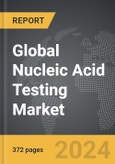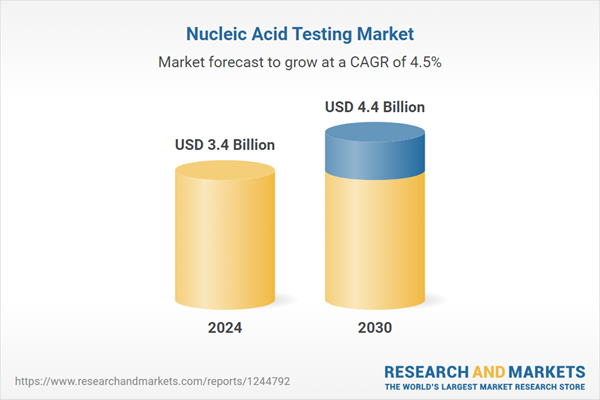The global market for Nucleic Acid Testing was valued at US$3.4 Billion in 2024 and is projected to reach US$4.4 Billion by 2030, growing at a CAGR of 4.5% from 2024 to 2030. This comprehensive report provides an in-depth analysis of market trends, drivers, and forecasts, helping you make informed business decisions. The report includes the most recent global tariff developments and how they impact the Nucleic Acid Testing market.
Technological advancements are propelling the NAT market forward by enhancing the capabilities and accessibility of this testing method. Improvements in polymerase chain reaction (PCR), real-time PCR, and next-generation sequencing (NGS) have broadened NAT's applications, making it faster, more accurate, and cost-effective. Additionally, the development of portable and point-of-care NAT devices allows for immediate diagnoses, extending the technology's reach beyond traditional lab settings into immediate patient care scenarios. These innovations support the growing trend toward personalized medicine, where treatments are tailored based on individual genetic profiles, improving treatment efficacy and patient safety. NAT is crucial in genotyping, pharmacogenomics, and cancer genomics, helping to identify genetic mutations that may influence the effectiveness of certain therapies. This precise approach enhances treatment efficacy and minimizes adverse drug reactions, leading to better patient outcomes.
The increasing application of NAT in genetic testing, forensic science, and the support of regulatory bodies and governments further boost market growth. NAT's ability to detect and quantify minute amounts of genetic material makes it invaluable in genetic research and diagnostics, as well as in forensic applications for identifying individuals in criminal investigations and disaster victim identification. As technology continues to evolve, the demand for precise and rapid diagnostics is expected to drive substantial growth in the NAT market, affirming its integral role in healthcare and scientific advancements.
Segments: Product Type (Nucleic Acid Test Kits, Consumables); End-Use (Research Institutes, Pathology Laboratories, Hospitals, Clinics).
Geographic Regions/Countries: World; United States; Canada; Japan; China; Europe (France; Germany; Italy; United Kingdom; Spain; Russia; and Rest of Europe); Asia-Pacific (Australia; India; South Korea; and Rest of Asia-Pacific); Latin America (Argentina; Brazil; Mexico; and Rest of Latin America); Middle East (Iran; Israel; Saudi Arabia; United Arab Emirates; and Rest of Middle East); and Africa.
The analysts continuously track trade developments worldwide, drawing insights from leading global economists and over 200 industry and policy institutions, including think tanks, trade organizations, and national economic advisory bodies. This intelligence is integrated into forecasting models to provide timely, data-driven analysis of emerging risks and opportunities.
Global Nucleic Acid Testing Market - Key Trends and Drivers Summarized
Nucleic Acid Testing (NAT) is a sophisticated biological technique used to detect specific sequences of DNA or RNA in a sample. This method has become indispensable in various fields, including medical diagnostics, forensic science, and biological research. Nucleic Acid Testing (NAT) is a vital molecular technique employed in various diagnostic and screening applications, particularly in the medical field. It utilizes advanced methodologies to detect the specific sequences of DNA or RNA from viruses, bacteria, or other pathogens present in blood, urine, or tissues. One of the primary drivers of the NAT market is its increasing use in medical diagnostics. NAT offers a highly sensitive method for detecting pathogens, including viruses and bacteria that cause diseases. Its ability to detect genetic material directly from pathogens enables earlier and more accurate diagnosis compared to traditional methods like culture techniques. This is particularly critical in the diagnosis of infectious diseases such as HIV, hepatitis B and C, tuberculosis, and COVID-19, where timely and precise detection can significantly influence treatment outcomes and patient recovery.Technological advancements are propelling the NAT market forward by enhancing the capabilities and accessibility of this testing method. Improvements in polymerase chain reaction (PCR), real-time PCR, and next-generation sequencing (NGS) have broadened NAT's applications, making it faster, more accurate, and cost-effective. Additionally, the development of portable and point-of-care NAT devices allows for immediate diagnoses, extending the technology's reach beyond traditional lab settings into immediate patient care scenarios. These innovations support the growing trend toward personalized medicine, where treatments are tailored based on individual genetic profiles, improving treatment efficacy and patient safety. NAT is crucial in genotyping, pharmacogenomics, and cancer genomics, helping to identify genetic mutations that may influence the effectiveness of certain therapies. This precise approach enhances treatment efficacy and minimizes adverse drug reactions, leading to better patient outcomes.
The increasing application of NAT in genetic testing, forensic science, and the support of regulatory bodies and governments further boost market growth. NAT's ability to detect and quantify minute amounts of genetic material makes it invaluable in genetic research and diagnostics, as well as in forensic applications for identifying individuals in criminal investigations and disaster victim identification. As technology continues to evolve, the demand for precise and rapid diagnostics is expected to drive substantial growth in the NAT market, affirming its integral role in healthcare and scientific advancements.
Report Scope
The report analyzes the Nucleic Acid Testing market, presented in terms of units. The analysis covers the key segments and geographic regions outlined below.Segments: Product Type (Nucleic Acid Test Kits, Consumables); End-Use (Research Institutes, Pathology Laboratories, Hospitals, Clinics).
Geographic Regions/Countries: World; United States; Canada; Japan; China; Europe (France; Germany; Italy; United Kingdom; Spain; Russia; and Rest of Europe); Asia-Pacific (Australia; India; South Korea; and Rest of Asia-Pacific); Latin America (Argentina; Brazil; Mexico; and Rest of Latin America); Middle East (Iran; Israel; Saudi Arabia; United Arab Emirates; and Rest of Middle East); and Africa.
Key Insights:
- Market Growth: Understand the significant growth trajectory of the Nucleic Acid Test Kits segment, which is expected to reach US$3.7 Billion by 2030 with a CAGR of a 5.0%. The Consumables segment is also set to grow at 1.7% CAGR over the analysis period.
- Regional Analysis: Gain insights into the U.S. market, valued at $905.0 Million in 2024, and China, forecasted to grow at an impressive 7.7% CAGR to reach $950.8 Million by 2030. Discover growth trends in other key regions, including Japan, Canada, Germany, and the Asia-Pacific.
Why You Should Buy This Report:
- Detailed Market Analysis: Access a thorough analysis of the Global Nucleic Acid Testing Market, covering all major geographic regions and market segments.
- Competitive Insights: Get an overview of the competitive landscape, including the market presence of major players across different geographies.
- Future Trends and Drivers: Understand the key trends and drivers shaping the future of the Global Nucleic Acid Testing Market.
- Actionable Insights: Benefit from actionable insights that can help you identify new revenue opportunities and make strategic business decisions.
Key Questions Answered:
- How is the Global Nucleic Acid Testing Market expected to evolve by 2030?
- What are the main drivers and restraints affecting the market?
- Which market segments will grow the most over the forecast period?
- How will market shares for different regions and segments change by 2030?
- Who are the leading players in the market, and what are their prospects?
Report Features:
- Comprehensive Market Data: Independent analysis of annual sales and market forecasts in US$ Million from 2024 to 2030.
- In-Depth Regional Analysis: Detailed insights into key markets, including the U.S., China, Japan, Canada, Europe, Asia-Pacific, Latin America, Middle East, and Africa.
- Company Profiles: Coverage of players such as Abbott Molecular, Inc., Beckman Coulter - Life Science Division, Becton, Dickinson and Company, Bio-Rad Laboratories, Inc., F. Hoffmann-La Roche AG and more.
- Complimentary Updates: Receive free report updates for one year to keep you informed of the latest market developments.
Some of the 46 companies featured in this Nucleic Acid Testing market report include:
- Abbott Molecular, Inc.
- Beckman Coulter - Life Science Division
- Becton, Dickinson and Company
- Bio-Rad Laboratories, Inc.
- F. Hoffmann-La Roche AG
- Illumina, Inc.
- Novartis International AG
- Sequenom, Inc.
- Siemens Healthineers
- Tecan Group Ltd.
Tariff Impact Analysis: Key Insights for 2025
Global tariff negotiations across 180+ countries are reshaping supply chains, costs, and competitiveness. This report reflects the latest developments as of April 2025 and incorporates forward-looking insights into the market outlook.The analysts continuously track trade developments worldwide, drawing insights from leading global economists and over 200 industry and policy institutions, including think tanks, trade organizations, and national economic advisory bodies. This intelligence is integrated into forecasting models to provide timely, data-driven analysis of emerging risks and opportunities.
What’s Included in This Edition:
- Tariff-adjusted market forecasts by region and segment
- Analysis of cost and supply chain implications by sourcing and trade exposure
- Strategic insights into geographic shifts
Buyers receive a free July 2025 update with:
- Finalized tariff impacts and new trade agreement effects
- Updated projections reflecting global sourcing and cost shifts
- Expanded country-specific coverage across the industry
Table of Contents
I. METHODOLOGYII. EXECUTIVE SUMMARY2. FOCUS ON SELECT PLAYERSIII. MARKET ANALYSISSOUTH KOREAREST OF ASIA-PACIFICARGENTINABRAZILMEXICOREST OF LATIN AMERICAIRANISRAELSAUDI ARABIAUNITED ARAB EMIRATESREST OF MIDDLE EASTIV. COMPETITION
1. MARKET OVERVIEW
3. MARKET TRENDS & DRIVERS
4. GLOBAL MARKET PERSPECTIVE
UNITED STATES
CANADA
JAPAN
CHINA
EUROPE
FRANCE
GERMANY
ITALY
UNITED KINGDOM
SPAIN
RUSSIA
REST OF EUROPE
ASIA-PACIFIC
AUSTRALIA
INDIA
LATIN AMERICA
MIDDLE EAST
AFRICA
Companies Mentioned (Partial List)
A selection of companies mentioned in this report includes, but is not limited to:
- Abbott Molecular, Inc.
- Beckman Coulter - Life Science Division
- Becton, Dickinson and Company
- Bio-Rad Laboratories, Inc.
- F. Hoffmann-La Roche AG
- Illumina, Inc.
- Novartis International AG
- Sequenom, Inc.
- Siemens Healthineers
- Tecan Group Ltd.
Table Information
| Report Attribute | Details |
|---|---|
| No. of Pages | 372 |
| Published | April 2025 |
| Forecast Period | 2024 - 2030 |
| Estimated Market Value ( USD | $ 3.4 Billion |
| Forecasted Market Value ( USD | $ 4.4 Billion |
| Compound Annual Growth Rate | 4.5% |
| Regions Covered | Global |









